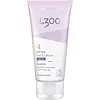What's inside
What's inside
 Key Ingredients
Key Ingredients

 Benefits
Benefits

 Concerns
Concerns

 Ingredients Side-by-side
Ingredients Side-by-side

Water
Skin ConditioningBetaine
HumectantGlycerin
HumectantCanola Oil
EmollientCaprylic/Capric Triglyceride
MaskingPolyglyceryl-3 Dicitrate/Stearate
EmulsifyingAvena Sativa Kernel Oil
Skin ConditioningSqualane
EmollientEthylhexyl Stearate
EmollientXylitylglucoside
HumectantCaprylyl Methicone
Skin ConditioningHydroxyethyl Acrylate/Sodium Acryloyldimethyl Taurate Copolymer
Emulsion StabilisingAnhydroxylitol
HumectantHydrogenated Coco-Glycerides
EmollientCetearyl Alcohol
EmollientXylitol
HumectantGlyceryl Stearates
EmollientPanthenol
Skin ConditioningPhenoxyethanol
PreservativeTocopheryl Acetate
AntioxidantEthylhexylglycerin
Skin ConditioningXanthan Gum
EmulsifyingCitric Acid
BufferingSorbitan Isostearate
EmulsifyingPolysorbate 60
EmulsifyingPantolactone
HumectantWater, Betaine, Glycerin, Canola Oil, Caprylic/Capric Triglyceride, Polyglyceryl-3 Dicitrate/Stearate, Avena Sativa Kernel Oil, Squalane, Ethylhexyl Stearate, Xylitylglucoside, Caprylyl Methicone, Hydroxyethyl Acrylate/Sodium Acryloyldimethyl Taurate Copolymer, Anhydroxylitol, Hydrogenated Coco-Glycerides, Cetearyl Alcohol, Xylitol, Glyceryl Stearates, Panthenol, Phenoxyethanol, Tocopheryl Acetate, Ethylhexylglycerin, Xanthan Gum, Citric Acid, Sorbitan Isostearate, Polysorbate 60, Pantolactone
Water
Skin ConditioningButyrospermum Parkii Butter
Skin ConditioningSimmondsia Chinensis Seed Oil
EmollientPrunus Amygdalus Dulcis Oil
Skin ConditioningGlycerin
HumectantCetearyl Alcohol
EmollientPentylene Glycol
Skin ConditioningGlyceryl Stearate
EmollientPalmitic/Stearic Triglyceride
Glyceryl Stearate Citrate
EmollientGluconolactone
Skin ConditioningPhragmites Karka Extract
Skin ConditioningPoria Cocos Extract
Skin ConditioningLactobacillus Ferment
Skin ConditioningLactobacillus
Skin ConditioningCocos Nucifera Fruit Extract
EmollientCeramide NP
Skin ConditioningGlyceryl Caprylate
EmollientTocopherol
AntioxidantCetearyl Olivate
Xanthan Gum
EmulsifyingSodium Citrate
BufferingSorbitan Olivate
EmulsifyingSodium Gluconate
Skin ConditioningCitric Acid
BufferingSodium Benzoate
MaskingWater, Butyrospermum Parkii Butter, Simmondsia Chinensis Seed Oil, Prunus Amygdalus Dulcis Oil, Glycerin, Cetearyl Alcohol, Pentylene Glycol, Glyceryl Stearate, Palmitic/Stearic Triglyceride, Glyceryl Stearate Citrate, Gluconolactone, Phragmites Karka Extract, Poria Cocos Extract, Lactobacillus Ferment, Lactobacillus, Cocos Nucifera Fruit Extract, Ceramide NP, Glyceryl Caprylate, Tocopherol, Cetearyl Olivate, Xanthan Gum, Sodium Citrate, Sorbitan Olivate, Sodium Gluconate, Citric Acid, Sodium Benzoate
Ingredients Explained
These ingredients are found in both products.
Ingredients higher up in an ingredient list are typically present in a larger amount.
Cetearyl alcohol is a mixture of two fatty alcohols: cetyl alcohol and stearyl alcohol. It is mainly used as an emulsifier. Emulsifiers help prevent the separation of oils and products. Due to its composition, it can also be used to thicken a product or help create foam.
Cetearyl alcohol is an emollient. Emollients help soothe and hydrate the skin by trapping moisture.
Studies show Cetearyl alcohol is non-toxic and non-irritating. The FDA allows products labeled "alcohol-free" to have fatty alcohols.
This ingredient is usually derived from plant oils such as palm, vegetable, or coconut oils. There is debate on whether this ingredient will cause acne.
Due to the fatty acid base, this ingredient may not be Malassezia folliculitis safe.
Learn more about Cetearyl AlcoholCitric Acid is an alpha hydroxy acid (AHA) naturally found in citrus fruits like oranges, lemons, and limes.
Like other AHAs, citric acid can exfoliate skin by breaking down the bonds that hold dead skin cells together. This helps reveal smoother and brighter skin underneath.
However, this exfoliating effect only happens at high concentrations (20%) which can be hard to find in cosmetic products.
Due to this, citric acid is usually included in small amounts as a pH adjuster. This helps keep products slightly more acidic and compatible with skin's natural pH.
In skincare formulas, citric acid can:
While it can provide some skin benefits, research shows lactic acid and glycolic acid are generally more effective and less irritating exfoliants.
Most citric acid used in skincare today is made by fermenting sugars (usually from molasses). This synthetic version is identical to the natural citrus form but easier to stabilize and use in formulations.
Read more about some other popular AHA's here:
Learn more about Citric AcidGlycerin is already naturally found in your skin. It helps moisturize and protect your skin.
A study from 2016 found glycerin to be more effective as a humectant than AHAs and hyaluronic acid.
As a humectant, it helps the skin stay hydrated by pulling moisture to your skin. The low molecular weight of glycerin allows it to pull moisture into the deeper layers of your skin.
Hydrated skin improves your skin barrier; Your skin barrier helps protect against irritants and bacteria.
Glycerin has also been found to have antimicrobial and antiviral properties. Due to these properties, glycerin is often used in wound and burn treatments.
In cosmetics, glycerin is usually derived from plants such as soybean or palm. However, it can also be sourced from animals, such as tallow or animal fat.
This ingredient is organic, colorless, odorless, and non-toxic.
Glycerin is the name for this ingredient in American English. British English uses Glycerol/Glycerine.
Learn more about GlycerinWater. It's the most common cosmetic ingredient of all. You'll usually see it at the top of ingredient lists, meaning that it makes up the largest part of the product.
So why is it so popular? Water most often acts as a solvent - this means that it helps dissolve other ingredients into the formulation.
You'll also recognize water as that liquid we all need to stay alive. If you see this, drink a glass of water. Stay hydrated!
Learn more about WaterXanthan gum is used as a stabilizer and thickener within cosmetic products. It helps give products a sticky, thick feeling - preventing them from being too runny.
On the technical side of things, xanthan gum is a polysaccharide - a combination consisting of multiple sugar molecules bonded together.
Xanthan gum is a pretty common and great ingredient. It is a natural, non-toxic, non-irritating ingredient that is also commonly used in food products.
Learn more about Xanthan Gum